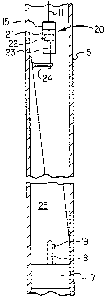Some of the information on this Web page has been provided by external sources. The Government of Canada is not responsible for the accuracy, reliability or currency of the information supplied by external sources. Users wishing to rely upon this information should consult directly with the source of the information. Content provided by external sources is not subject to official languages, privacy and accessibility requirements.
Any discrepancies in the text and image of the Claims and Abstract are due to differing posting times. Text of the Claims and Abstract are posted:
| (12) Patent: | (11) CA 2192185 |
|---|---|
| (54) English Title: | METHOD FOR SETTING A WHIPSTOCK IN A WELLBORE |
| (54) French Title: | PROCEDE PERMETTANT DE PLACER UN SIFFLET DEVIATEUR DANS UN PUITS DE FORAGE |
| Status: | Term Expired - Post Grant Beyond Limit |
| (51) International Patent Classification (IPC): |
|
|---|---|
| (72) Inventors : |
|
| (73) Owners : |
|
| (71) Applicants : |
|
| (74) Agent: | NORTON ROSE FULBRIGHT CANADA LLP/S.E.N.C.R.L., S.R.L. |
| (74) Associate agent: | |
| (45) Issued: | 2001-07-24 |
| (86) PCT Filing Date: | 1995-05-25 |
| (87) Open to Public Inspection: | 1995-12-14 |
| Examination requested: | 1997-06-05 |
| Availability of licence: | N/A |
| Dedicated to the Public: | N/A |
| (25) Language of filing: | English |
| Patent Cooperation Treaty (PCT): | Yes |
|---|---|
| (86) PCT Filing Number: | PCT/GB1995/001196 |
| (87) International Publication Number: | GB1995001196 |
| (85) National Entry: | 1996-12-05 |
| (30) Application Priority Data: | ||||||
|---|---|---|---|---|---|---|
|
A method for setting a whipstock (25) in a wellbore (2) on a packer-anchor (17)
which employs a wireline (11) that carries a setting assembly (20, 35) which severs a
shear member (24, 33) carried by the setting assembly after the whipstock is set onto the
packer-anchor.
Un procédé permet de placer un sifflet déviateur (25) dans un puits de forage (2) sur un ancrage-garniture d'étanchéité (17). Il consiste à utiliser un câble métallique (11) qui porte un ensemble de placement (20, 35) chargé de couper un élément de cisaillement (24, 33) porté par cet ensemble de placement, une fois que le sifflet déviateur est en place sur l'ancrage-garniture d'étanchéité.
Note: Claims are shown in the official language in which they were submitted.
Note: Descriptions are shown in the official language in which they were submitted.

2024-08-01:As part of the Next Generation Patents (NGP) transition, the Canadian Patents Database (CPD) now contains a more detailed Event History, which replicates the Event Log of our new back-office solution.
Please note that "Inactive:" events refers to events no longer in use in our new back-office solution.
For a clearer understanding of the status of the application/patent presented on this page, the site Disclaimer , as well as the definitions for Patent , Event History , Maintenance Fee and Payment History should be consulted.
| Description | Date |
|---|---|
| Inactive: Expired (new Act pat) | 2015-05-25 |
| Letter Sent | 2004-05-27 |
| Inactive: Office letter | 2004-02-10 |
| Grant by Issuance | 2001-07-24 |
| Inactive: Cover page published | 2001-07-23 |
| Inactive: Inventor deleted | 2001-05-16 |
| Inactive: Final fee received | 2001-04-10 |
| Pre-grant | 2001-04-10 |
| Letter Sent | 2000-10-13 |
| Notice of Allowance is Issued | 2000-10-13 |
| Notice of Allowance is Issued | 2000-10-13 |
| Inactive: Approved for allowance (AFA) | 2000-09-28 |
| Inactive: RFE acknowledged - Prior art enquiry | 1997-09-04 |
| Inactive: Status info is complete as of Log entry date | 1997-08-28 |
| Inactive: Application prosecuted on TS as of Log entry date | 1997-08-28 |
| All Requirements for Examination Determined Compliant | 1997-06-05 |
| Request for Examination Requirements Determined Compliant | 1997-06-05 |
| Application Published (Open to Public Inspection) | 1995-12-14 |
There is no abandonment history.
The last payment was received on 2001-04-25
Note : If the full payment has not been received on or before the date indicated, a further fee may be required which may be one of the following
Patent fees are adjusted on the 1st of January every year. The amounts above are the current amounts if received by December 31 of the current year.
Please refer to the CIPO
Patent Fees
web page to see all current fee amounts.
Note: Records showing the ownership history in alphabetical order.
| Current Owners on Record |
|---|
| PHILLIPS PETROLEUM COMPANY |
| ATLANTIC RICHFIELD COMPANY |
| CHARLES D. HAILEY |
| Past Owners on Record |
|---|
| CHARLES M. HIGHTOWER |
| CURTIS G. BLOUNT |